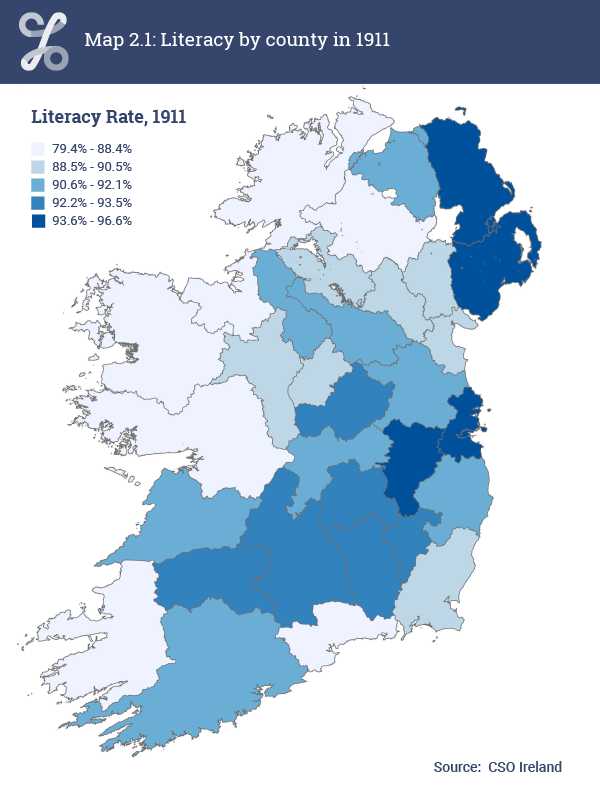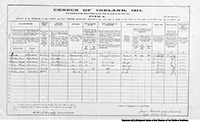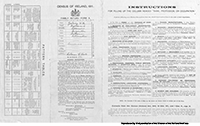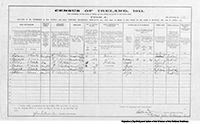The counties with the highest literacy rates were in the East and North-East of the country, while those counties with lower literacy rates tended to be in the West (See Map 2.1).

The DEDs with the highest literacy rates were in areas around Tipperary and Dublin, and the North-East (darker shades in Map 2.2). Less literate DEDs tended to be in the West of the country (lighter shades in Map 2.2) (See PxStat table HCA09 and Map 2.2).
Out of the 20 DEDs with the highest literacy rates, 11 were in Leinster and seven were in Ulster. Five of the top 20 DEDs with the highest literacy rates were in Down, the highest number for any county. The remaining 15 DEDs in the top 20 were in Dublin City (four), Dublin County (four), Kildare (two) and one each Antrim, Belfast City, Clare, Queens County, and Tipperary (See Table 2.2).
Out of the 20 DEDs with the lowest literacy rates, 14 were in Connaught while there were none from Leinster. Galway had 13 DEDs out of the 20 DEDs with the lowest literacy rates, the highest amount for any county. The remaining DEDs were in Donegal (5), Kerry (1) and Mayo (1) (See Table 2.3).
Donaghadee Urban DED in Down had one of the highest literacy rates in 1911 with a literacy rate of 99.7%. Donaghadee Urban had a population of 1,797 aged nine years and over, of which five were illiterate (See Table 2.4).
Lettermore DED in Galway was identified as the DED with one of the lowest literacy rates in 1911 with a literacy rate of 38.8%. Lettermore had a population of 1,003 aged nine years and over, of which 614 persons were illiterate (See Table 2.4).
In the Census of Ireland, 1911, the Louden household were recorded as living in Donaghadee Urban DED, Down. The Louden household consisted of six people – a married couple (James and Barbara Anna Louden) and four children (Benjamin George, Henry Thomas, Margaret Isabella, and William James). They were all able to read and write except for their youngest child, William James (aged six), who could read only. James Louden had an occupation of druggist and grocer, and all four children were recorded as scholars. Their house was recorded as a shop, presumably where James Louden worked and nine rooms in the house were occupied by the Loudens.
The original Census Form A for the Louden household can be found on the National Archives website (See Figure 2.1 and Figure 2.2).
The Form B. 1. House and Building Return contains a description of the Louden’s property (house 1) and can be found on the National Archives website (See Figure 2.3).

Figure 2.1: Cover page Form A from Census of Ireland, 1911 for family living in Bridge Street in Donaghadee, County Down. Acknowledgement: Reproduced by kind permission of the Director of the National Archives.
Download this image
Figure 2.2: Form A from Census of Ireland, 1911 for family living in Bridge Street, Donaghadee, County Down. Acknowledgement: Reproduced by kind permission of the Director of the National Archives.
Download this image
Figure 2.3: Form B 1 from Census of Ireland, 1911 for Bridge Street in Donaghadee, County Down. Acknowledgement: Reproduced by kind permission of the Director of the National Archives.
Download this imageIn the Census of Ireland, 1911, the O’Toole household were recorded as living in Lettermore DED, Galway. The O’Toole household consisted of six people – a married couple (Colman and Bridget O’Toole) and four children (Colman, Barbara, Margaret, and Catherine). No one in the O’Toole household could read and they all spoke Irish only. Their house contained just one room and this household Census form records the roof of this house as being of ‘thatch, wood or other perishable material’ while the walls were of ‘stone, brick or concrete’.
The original Census Form A for the O’Toole household can be found on the National Archives website (See Figure 2.4 and Figure 2.5).
The Form B. 1. House and Building Return contains a description of the O’Tooles’ property (house 23) and can be found on the National Archives website (See Figure 2.6).

Figure 2.4: Cover page Form A from Census of Ireland, 1911 for family living in Lettermore, County Galway. Acknowledgement: Reproduced by kind permission of the Director of the National Archives.
Download this image
Figure 2.5: Form A from Census of Ireland, 1911 for family living in Lettermore, County Galway. Acknowledgement: Reproduced by kind permission of the Director of the National Archives.
Download this image
Figure 2.6: Form B 1 from Census of Ireland, 1911 for Lettercallow in Lettermore, County Galway. Acknowledgement: Reproduced by kind permission of the Director of the National Archives.
Download this imageLearn about our data and confidentiality safeguards, and the steps we take to produce statistics that can be trusted by all.